NEC MultiSync EA244UHD 24-Inch 4K Monitor Review
Calibration and Controls
Like most monitors, NEC provides a set of pre-configured modes for different viewing scenarios. They include Standard, Text (makes letters and lines crisp), Movie (boosts dark tones), Gaming (boosts whole tones), Photo (optimizes contrast), and Dynamic (adjusts the brightness by detecting the screens black areas and optimizes it).
NEC opted for touch sensitive controls. We typically prefer physical buttons, which are usually more responsive and easier to find in the dark, though as implemented here, the touch sensitive controls worked fine during our time with the monitor. We didn't experience any extended lag or find ourselves having to repeatedly tap the bezel because it didn't register the first time, so kudos to NEC there.
NEC opted for touch sensitive controls. We typically prefer physical buttons, which are usually more responsive and easier to find in the dark, though as implemented here, the touch sensitive controls worked fine during our time with the monitor. We didn't experience any extended lag or find ourselves having to repeatedly tap the bezel because it didn't register the first time, so kudos to NEC there.
 |
|
We're now using DisplayMate for Windows (www.displaymate.com) as part of our monitor evaluation process. DisplayMate's smorgasbord of tests allow us to root out potential problems areas, such as geometry distortion and color inaccuracies, to name just two.
It didn't take long for DisplayMate to expose some flaws with the EA244UHD's out-of-box performance, such as black level performance. Stock blacks trended towards being a tad bright, though the good news here is that it's an easy fix -- there's a black level option in the monitor's OSD controls. Reducing it a few notches made a world of difference and looked darn near perfect to our eyes. It's always refreshing when a visual quality weakness ends up being a setting issue rather than a shortcoming of the actual panel.
We noticed the same need for tweaking to optimize gray level performance, which is a matter of adjusting the contrast. Out of the box, the EA244UHD let brightness and whites dominate the more subtle gray level tones, but once again, a quick adjustment in the OSD controls transformed the output from good to excellent.
As would be expected, fine print is a bit tough on the eyes, though only because it appears so small on a 4K panel. Otherwise, the EA244UHD began to show off about midway through our DisplayMate run. One of the harder tests to ace is the video bandwidth index, and while scores of 100 are supposed to be extremely hard to achieve, that's what we came up when evaluating this panel. A rare sight in our experience, and a well deserved kudos to NEC.

It didn't take long for DisplayMate to expose some flaws with the EA244UHD's out-of-box performance, such as black level performance. Stock blacks trended towards being a tad bright, though the good news here is that it's an easy fix -- there's a black level option in the monitor's OSD controls. Reducing it a few notches made a world of difference and looked darn near perfect to our eyes. It's always refreshing when a visual quality weakness ends up being a setting issue rather than a shortcoming of the actual panel.
We noticed the same need for tweaking to optimize gray level performance, which is a matter of adjusting the contrast. Out of the box, the EA244UHD let brightness and whites dominate the more subtle gray level tones, but once again, a quick adjustment in the OSD controls transformed the output from good to excellent.
As would be expected, fine print is a bit tough on the eyes, though only because it appears so small on a 4K panel. Otherwise, the EA244UHD began to show off about midway through our DisplayMate run. One of the harder tests to ace is the video bandwidth index, and while scores of 100 are supposed to be extremely hard to achieve, that's what we came up when evaluating this panel. A rare sight in our experience, and a well deserved kudos to NEC.

NEC tells us the EA244UHD isn't a professional monitor for artists and graphics designers, who'd be better served browsing the company's PA Series. That said, professionals on a budget could probably get away with using the EA244UHD for some projects, though some hands-on calibration will go a long way. The photos we viewed on the monitor looked crisp and sharp, though also slightly bright, which took away some of the richness. Bear in mind we're nitpicking here -- compared to a standard LED monitor, the EA244UHD is miles ahead. It's only when compared to a professional series monitor that some of the subtle flaws come through, and even then, they're minor and mostly fixable.











